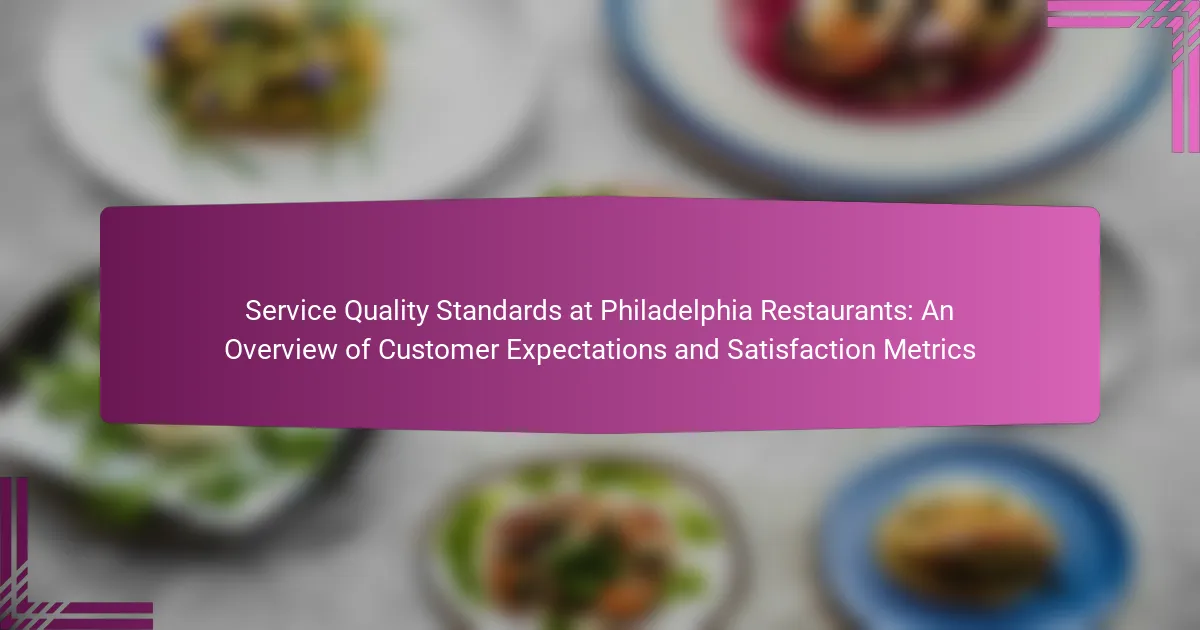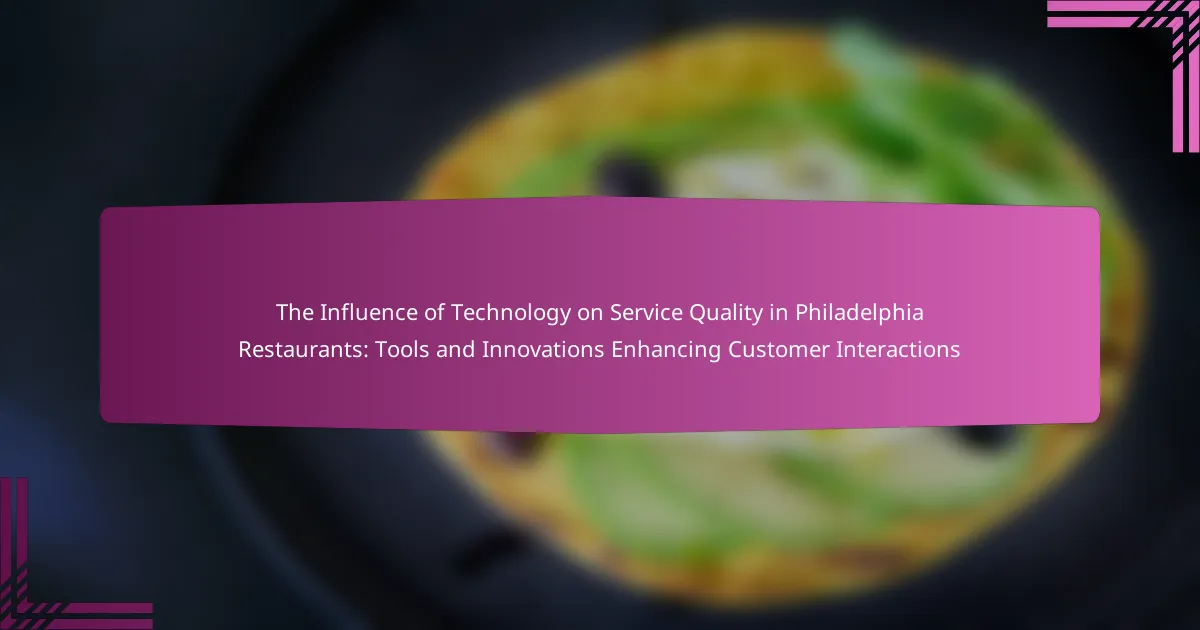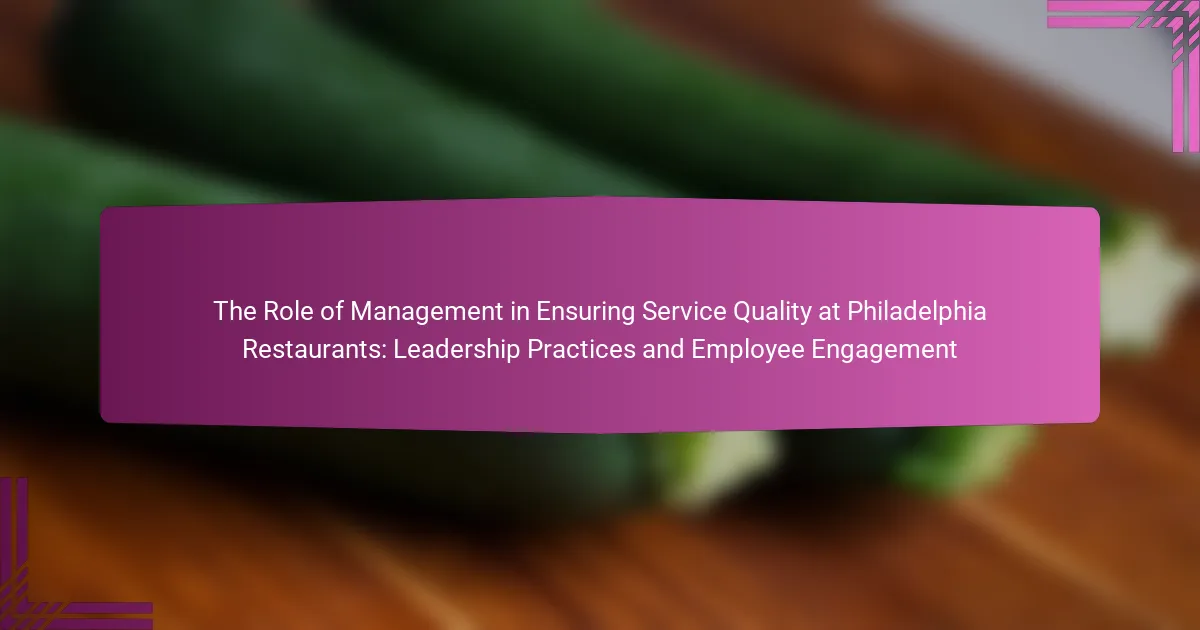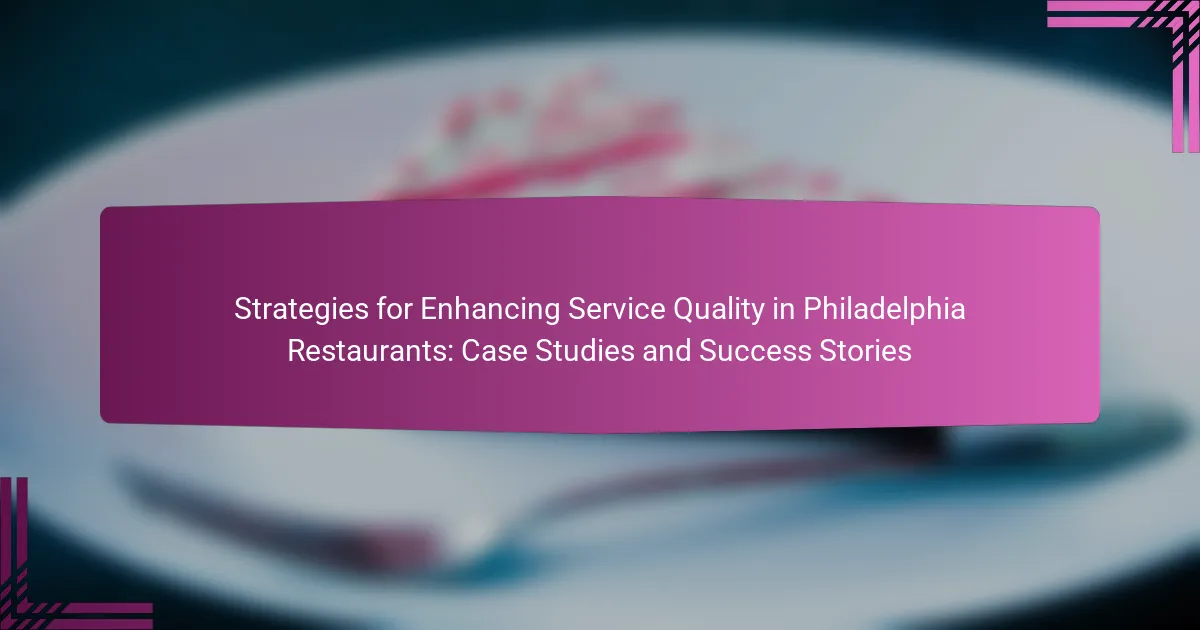
What are the Service Quality Standards at Philadelphia Restaurants?
Service quality standards at Philadelphia restaurants include promptness, cleanliness, and customer service. Promptness involves timely service from the moment a customer arrives. Cleanliness refers to the hygiene of both the dining area and restrooms. Customer service encompasses staff friendliness and attentiveness to needs. Restaurants also adhere to food safety regulations to ensure quality. These standards are essential for customer satisfaction and repeat business. According to the National Restaurant Association, 70% of customers prioritize service quality when choosing dining establishments.
How do these standards impact customer expectations?
Service quality standards significantly shape customer expectations in Philadelphia restaurants. These standards set a baseline for service delivery, influencing what customers anticipate during their dining experience. For instance, high standards lead customers to expect prompt service, quality food, and a clean environment. Research indicates that 70% of customers base their satisfaction on service quality (American Customer Satisfaction Index, 2022). As a result, restaurants that consistently meet or exceed these standards tend to enjoy higher customer loyalty and positive reviews. Conversely, failing to meet established standards can lead to dissatisfaction and negative perceptions. Thus, maintaining high service quality standards is essential for meeting and managing customer expectations effectively.
What specific attributes define service quality in restaurants?
Service quality in restaurants is defined by attributes such as responsiveness, reliability, assurance, empathy, and tangibles. Responsiveness refers to the willingness of staff to help customers and provide prompt service. Reliability indicates the ability to deliver promised services consistently and accurately. Assurance encompasses the knowledge and courtesy of employees, instilling confidence in customers. Empathy involves providing caring, individualized attention to customers. Tangibles include the appearance of physical facilities, equipment, personnel, and communication materials. These attributes collectively influence customer satisfaction and dining experiences, as confirmed by various studies in hospitality management.
How do Philadelphia restaurants compare to national service standards?
Philadelphia restaurants generally meet or exceed national service standards. According to a 2022 survey by the National Restaurant Association, 75% of Philadelphia diners reported satisfaction with service quality. This is higher than the national average of 68%. Factors contributing to this include attentive staff, timely service, and a focus on customer experience. The city’s culinary scene also emphasizes hospitality training, which enhances service consistency. Additionally, local reviews on platforms like Yelp show that many establishments receive high ratings for service. This indicates that Philadelphia restaurants are competitive in the national landscape regarding service quality.
Why is customer satisfaction important in the restaurant industry?
Customer satisfaction is crucial in the restaurant industry because it directly impacts customer loyalty and repeat business. Satisfied customers are more likely to return and recommend the restaurant to others. According to a study by the National Restaurant Association, 70% of customers will return to a restaurant if they had a positive experience. High levels of customer satisfaction can also lead to positive online reviews, which influence potential customers. Additionally, satisfied customers tend to spend more, increasing revenue for the restaurant. Therefore, maintaining high customer satisfaction is essential for the long-term success of restaurants.
What metrics are used to measure customer satisfaction?
Common metrics used to measure customer satisfaction include Customer Satisfaction Score (CSAT), Net Promoter Score (NPS), and Customer Effort Score (CES). CSAT gauges customer satisfaction through direct feedback, usually via a simple survey question. NPS assesses customer loyalty by asking how likely customers are to recommend a service. CES measures the ease of customer interactions, focusing on the effort required to resolve issues. These metrics provide valuable insights into customer perceptions and experiences. Research shows that companies using these metrics effectively can enhance service quality and improve customer retention.
How can restaurants improve customer satisfaction through service quality?
Restaurants can improve customer satisfaction through enhanced service quality by training staff effectively. Well-trained employees provide faster and more attentive service. This leads to a better dining experience for customers. Additionally, implementing a feedback system allows restaurants to understand customer needs. Responding to feedback can help address issues promptly. Research shows that 70% of customers are more likely to return if their complaints are resolved. Furthermore, maintaining a clean and welcoming environment contributes to positive perceptions of service quality. According to a study by the National Restaurant Association, cleanliness significantly impacts customer satisfaction ratings.

What are the key components of service quality in Philadelphia restaurants?
The key components of service quality in Philadelphia restaurants include reliability, responsiveness, assurance, empathy, and tangibles. Reliability refers to the ability to deliver promised services consistently. A study by Zeithaml et al. (1996) highlights that customers expect restaurants to provide accurate orders and timely service. Responsiveness is the willingness to help customers and provide prompt service. According to a survey by the National Restaurant Association, quick service is a top priority for diners. Assurance encompasses the knowledge and courtesy of staff, which builds customer trust. Empathy involves providing personalized attention to customers, as noted in research by Parasuraman et al. (1988). Finally, tangibles relate to the physical facilities, equipment, and appearance of personnel, which influence customers’ perceptions of quality.
How does staff training influence service quality?
Staff training significantly enhances service quality in restaurants. Trained staff exhibit improved communication skills. This leads to better interactions with customers. They are also more knowledgeable about the menu. This knowledge allows them to make informed recommendations. Furthermore, training equips staff with problem-solving skills. This enables them to handle customer complaints effectively. Research shows that well-trained staff can increase customer satisfaction by up to 20%. Overall, effective staff training directly correlates with higher service quality.
What best practices should be implemented for effective staff training?
Effective staff training should include clear objectives, practical exercises, and ongoing feedback. Establishing clear objectives helps staff understand expectations and desired outcomes. Practical exercises allow employees to apply their knowledge in real-world scenarios. Ongoing feedback ensures continuous improvement and reinforces learning. Research indicates that structured training programs can increase employee performance by up to 20%. Additionally, incorporating role-playing and simulations enhances engagement and retention of information. Regular assessments can measure training effectiveness and identify areas for improvement. Implementing these best practices leads to higher service quality and customer satisfaction in restaurants.
How does employee satisfaction relate to customer service quality?
Employee satisfaction directly impacts customer service quality. Satisfied employees are more motivated and engaged in their work. They provide better service to customers. A study by the Harvard Business Review found that companies with high employee satisfaction scores also have higher customer satisfaction ratings. This correlation occurs because happy employees are more likely to create positive interactions with customers. Positive interactions lead to increased customer loyalty and retention. Therefore, enhancing employee satisfaction is crucial for improving overall service quality.
What role does ambiance play in customer perceptions of service quality?
Ambiance significantly influences customer perceptions of service quality. A well-designed ambiance can enhance the overall dining experience. Factors such as lighting, music, and decor contribute to this perception. Studies show that 80% of customers consider ambiance when evaluating service quality. For instance, a warm and inviting atmosphere can lead to higher customer satisfaction. Conversely, a poorly maintained environment can detract from perceived service quality. Research indicates that customers are willing to pay more for a better ambiance. Thus, ambiance plays a crucial role in shaping customer expectations and satisfaction metrics in restaurants.
How can restaurant design enhance the dining experience?
Restaurant design enhances the dining experience by creating an inviting atmosphere. A well-thought-out layout facilitates smooth movement and interaction among guests and staff. Comfortable seating encourages patrons to linger and enjoy their meals. Effective lighting sets the mood and highlights key design features. Acoustic design minimizes noise and enhances conversation. Color schemes can evoke specific emotions and influence appetite. Thematic decor can create a unique identity that resonates with customers. Studies show that ambiance significantly impacts customer satisfaction and return visits.
What aspects of ambiance are most valued by customers?
Customers most value lighting, decor, and noise levels in restaurant ambiance. Proper lighting creates a warm and inviting atmosphere. Customers prefer soft, adjustable lighting for comfort. Attractive decor enhances the dining experience. Unique design elements can make a restaurant memorable. Noise levels significantly impact customer satisfaction. A quieter environment allows for better conversation. Studies show that 70% of diners prefer a calm atmosphere. These aspects collectively influence repeat visits and overall satisfaction.

How do Philadelphia restaurants gather feedback on service quality?
Philadelphia restaurants gather feedback on service quality through various methods. Common approaches include customer surveys, comment cards, and online reviews. Many establishments utilize digital platforms for real-time feedback. This can include social media interactions and dedicated feedback apps. Additionally, some restaurants conduct follow-up calls or emails after a dining experience. In-person feedback is also encouraged during the meal. These methods help restaurants assess customer satisfaction and identify areas for improvement. For instance, a study by the National Restaurant Association highlights that 70% of restaurants use customer surveys to gather insights.
What methods are commonly used to collect customer feedback?
Surveys and questionnaires are commonly used to collect customer feedback. These tools can be distributed online or in-person. They allow customers to provide structured responses about their experiences. Interviews are another effective method for gathering detailed feedback. They enable direct interaction between staff and customers. Focus groups facilitate discussions among a small group of customers. This method helps to uncover deeper insights into customer preferences. Social media platforms also serve as a valuable channel for feedback collection. Customers can share their opinions and experiences in real-time. Lastly, comment cards are often placed at tables in restaurants. They provide a simple way for customers to express their thoughts. Each of these methods offers unique advantages for understanding customer satisfaction.
How effective are online reviews in shaping service quality standards?
Online reviews are highly effective in shaping service quality standards. They influence customer perceptions and expectations significantly. According to a study by BrightLocal, 87% of consumers read online reviews for local businesses. Furthermore, 73% of customers trust a business more if it has positive reviews. These reviews provide direct feedback to service providers. This feedback helps identify areas for improvement. Additionally, online reviews can impact a restaurant’s reputation and visibility. A higher rating often correlates with increased customer traffic. Thus, online reviews play a crucial role in establishing and maintaining service quality standards in restaurants.
What role do surveys play in understanding customer expectations?
Surveys play a critical role in understanding customer expectations. They gather direct feedback from customers about their experiences and preferences. This data helps businesses identify gaps between expectations and actual service delivery. Surveys can reveal specific areas where improvements are needed. For example, a study by the American Customer Satisfaction Index found that customer feedback significantly influences service enhancements. Additionally, surveys can track changes in customer expectations over time. This ongoing assessment allows businesses to adapt their services accordingly. Overall, surveys are essential tools for aligning service offerings with customer needs.
What challenges do restaurants face in maintaining service quality?
Restaurants face several challenges in maintaining service quality. High employee turnover is a significant issue. According to the National Restaurant Association, the industry experiences an average turnover rate of 75%. This leads to inconsistencies in service as new staff may lack proper training.
Another challenge is managing customer expectations. Customers often have high standards based on previous experiences or online reviews. Meeting these expectations consistently can be difficult.
Additionally, operational issues such as supply chain disruptions can affect service quality. For example, delays in ingredient delivery can lead to menu changes, frustrating customers.
Finally, managing peak times effectively is crucial. During busy hours, staff may struggle to provide attentive service, leading to longer wait times and dissatisfied customers.
How can restaurants address staffing shortages while ensuring quality service?
Restaurants can address staffing shortages by implementing flexible scheduling and cross-training employees. Flexible scheduling allows staff to work hours that suit their availability. This can increase employee satisfaction and retention. Cross-training enables employees to perform multiple roles. This reduces dependency on specific staff members.
Additionally, investing in technology can streamline operations. Tools like online ordering and reservation systems can reduce staff workload. This allows existing employees to focus on delivering quality service.
Furthermore, offering competitive wages and benefits attracts more applicants. According to the National Restaurant Association, higher wages can improve employee retention.
Finally, fostering a positive work environment boosts morale. Engaged employees are more likely to provide excellent customer service.
What strategies can be employed to manage peak service times effectively?
Implementing effective strategies to manage peak service times involves optimizing staff scheduling, enhancing communication, and utilizing technology. Staff scheduling should align with anticipated customer volume. This ensures adequate coverage during busy periods. Enhanced communication among team members improves coordination. It reduces delays in service delivery. Technology can streamline operations. For instance, reservation systems help manage customer flow. Additionally, mobile ordering reduces wait times. These strategies have been shown to improve customer satisfaction. A study by the National Restaurant Association found that efficient service directly correlates with positive dining experiences.
What are some best practices for enhancing service quality in Philadelphia restaurants?
Implementing staff training programs enhances service quality in Philadelphia restaurants. Regular training ensures employees understand customer service standards. Training should focus on communication skills and problem-solving techniques. Establishing a clear feedback mechanism helps identify areas for improvement. Encouraging staff to engage with customers fosters a welcoming atmosphere. Utilizing technology for reservations and orders streamlines service efficiency. Monitoring service performance through customer feedback is essential for continuous improvement. According to a survey by the National Restaurant Association, 83% of customers value attentive service, highlighting its importance in the dining experience.
How can restaurants implement continuous improvement practices?
Restaurants can implement continuous improvement practices by adopting systematic feedback mechanisms. They can gather customer feedback through surveys and comment cards. Analyzing this feedback helps identify areas needing enhancement. Training staff regularly on service standards is crucial for maintaining quality. Implementing standard operating procedures ensures consistency in service delivery. Monitoring performance metrics like customer satisfaction scores provides valuable insights. Engaging in regular staff meetings fosters a culture of open communication and idea sharing. Utilizing technology for inventory and service management can streamline operations and reduce waste. These practices lead to improved service quality and customer satisfaction.
What are the benefits of establishing a service quality feedback loop?
Establishing a service quality feedback loop enhances customer satisfaction and improves service delivery. It allows restaurants to gather real-time insights from customers. These insights help identify areas needing improvement. Implementing changes based on feedback can lead to better service experiences. According to a study by the American Customer Satisfaction Index, businesses that actively seek customer feedback see a 10-15% increase in customer loyalty. Additionally, a feedback loop fosters a culture of continuous improvement among staff. It encourages employees to engage with customers more effectively. Ultimately, this leads to higher overall ratings and positive word-of-mouth for the restaurant.
Service Quality Standards at Philadelphia Restaurants focus on attributes such as promptness, cleanliness, and customer service, which collectively shape customer expectations and satisfaction. The article outlines how these standards impact customer loyalty, with 70% of diners prioritizing service quality when choosing restaurants. It also examines the metrics used to measure customer satisfaction, including CSAT and NPS, and highlights the importance of effective staff training and restaurant ambiance in enhancing service quality. Additionally, the article discusses challenges faced by restaurants in maintaining these standards and offers strategies for continuous improvement and feedback collection.



